

Online Etymology Dictionary. Old English blæc "dark," from Proto-Germanic *blakaz "burned" (cognates: Old Norse blakkr "dark," Old High German blah "black," Swedish bläck "ink," Dutch blaken "to burn"), from PIE *bhleg- "to burn, gleam, shine, flash" (cognates: Greek phlegein "to burn, scorch," Latin flagrare "to blaze, glow, burn"), from root *bhel- (1) "to shine, flash, burn;" see bleach (v.).

All About the Color BLACK. Black Sun (occult symbol) A depiction of the "Black Sun" the design of which is based primarily on the shape of the Wewelsburg sunwheel mosaic in the "Obergruppenführer"-Hall (SS Generals' Hall).
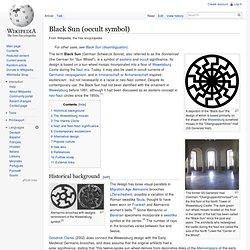
Heraldry. Black tie. Men's black tie dress (double-breasted jacket) History[edit] When the dinner jacket (tuxedo in American English) first came into fashion in the Victorian era, it was used as a less formal alternative for the tailcoat which men of the upper classes wore every evening.
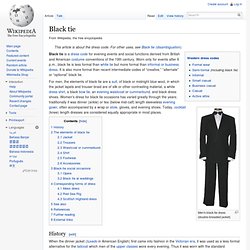
Thus it was worn with the standard accompaniments for the evening tailcoat at the time: matching trousers, white or black waistcoat, white bow tie, white detachable wing-collar formal shirt and black formal shoes. Lapels were often faced or edged in silk or satin in varying widths. Dinner jackets were considered from the first less formal than full dress (cutaway) and etiquette guides declared it inappropriate for wear in mixed company.[1] Mourning. Girl in mourning dress holding framed photograph of her father, who presumably died during the American Civil War.
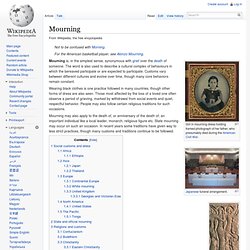
Egyptian women in a sorrowful gesture of mourning. Mourning is, in the simplest sense, synonymous with grief over the death of someone. The word is also used to describe a cultural complex of behaviours in which the bereaved participate or are expected to participate. Customs vary between different cultures and evolve over time, though many core behaviors remain constant.
Wearing black clothes is one practice followed in many countries, though other forms of dress are also seen. Mourning may also apply to the death of, or anniversary of the death of, an important individual like a local leader, monarch, religious figure etc. List of black flags. In history[edit] The Anarchist black flag has been an anarchist symbol since the 1880s.
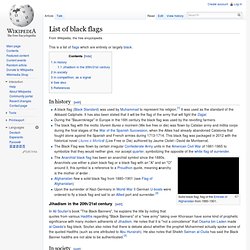
Anarchists use either a plain black flag or a black flag with an "A" and an "O" around it, this symbol is a reference to a Proudhon quote, meaning anarchy is the mother of order .Afghanistan flew a solid black flag from 1880–1901 (see Flag of Afghanistan)Upon the surrender of Nazi Germany in World War II German U-boats were ordered to fly a black flag and sail to an Allied port and surrender.[2] Jihadism in the 20th/21st century[edit] In Ali Soufan's book "The Black Banners", he explains the title by noting that quotes from various Hadiths regarding "Black Banners" of a "new army" taking over Khorasan have some kind of prophetic significance with many modern adherents of Jihadism. He notes that it is "not a coincidence" that Osama bin Laden made al-Qaeda's flag black.
In society[edit] In competition, as a signal[edit] Academic dress. Academic dress is a traditional form of clothing for academic settings, primarily tertiary (and sometimes secondary) education, worn mainly by those who have been admitted to a university degree (or similar), or hold a status that entitles them to assume them (e.g., undergraduate students at certain old universities).[1] It is also known as academicals and, in the United States, as academic regalia.
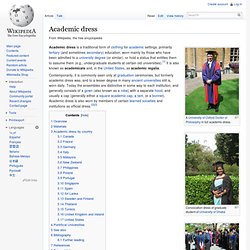
Overview[edit] Black Watch. Detail from a painting showing Black Watch recruits being reviewed on Glasgow Green, c.1758.
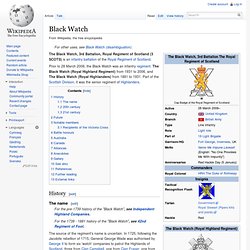
The Black Watch, 3rd Battalion, Royal Regiment of Scotland (3 SCOTS) is an infantry battalion of the Royal Regiment of Scotland. History[edit] The name[edit] The source of the regiment's name is uncertain. In 1725, following the Jacobite rebellion of 1715, General George Wade was authorised by George II to form six 'watch' companies to patrol the Highlands of Scotland, three from Clan Campbell, one from Clan Fraser, one from Clan Munro and one from Clan Grant. This epithet may have come from the uniform plaids of dark tartan with which the companies were provided. The 1st Battalion then served in Africa taking part in the Highland Brigade's dawn assault on the Egyptian position at Tel-el-Kebir in 1882.
Black.